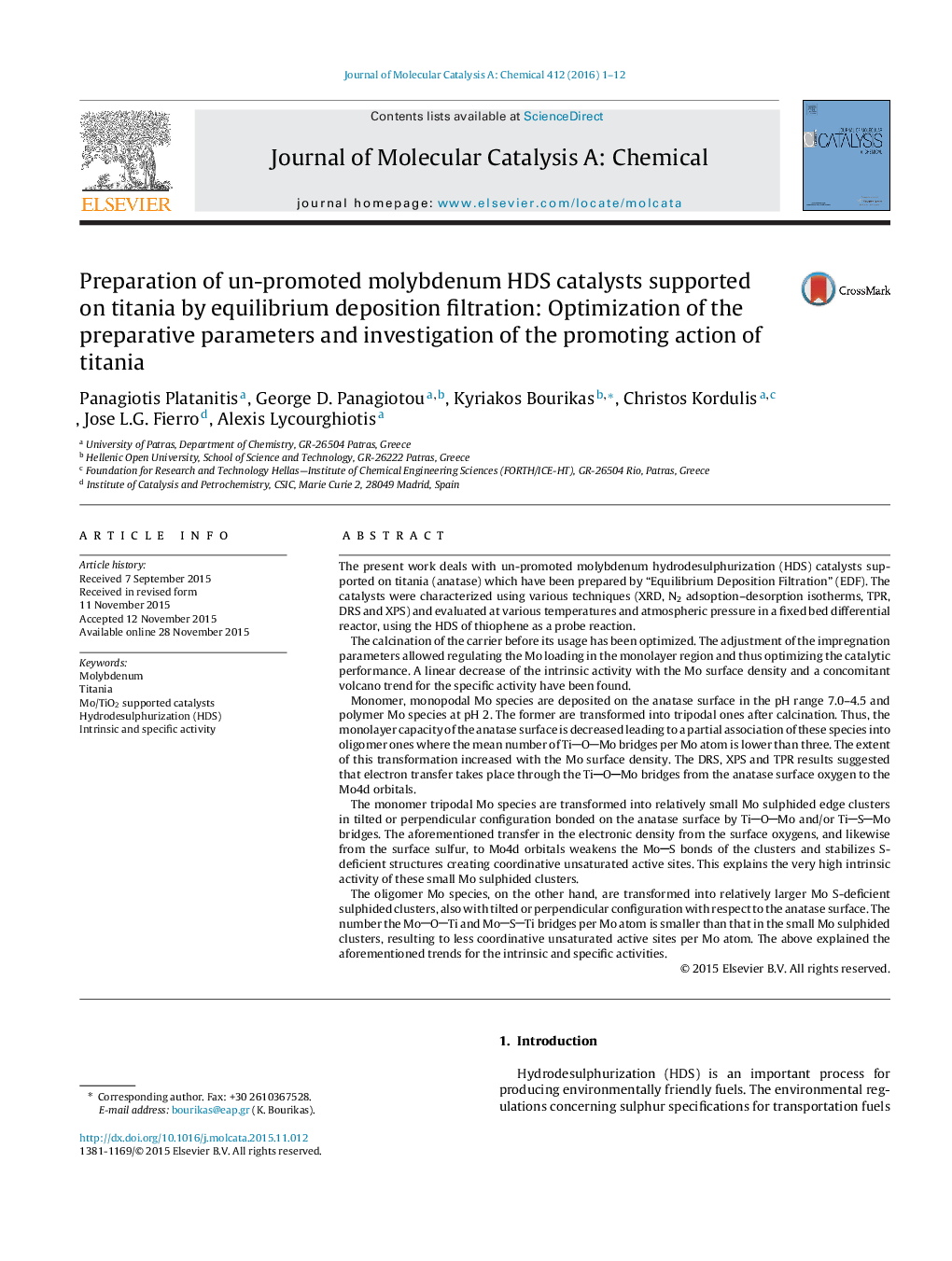| کد مقاله | کد نشریه | سال انتشار | مقاله انگلیسی | نسخه تمام متن |
|---|---|---|---|---|
| 64804 | 48371 | 2016 | 12 صفحه PDF | دانلود رایگان |

• EDF technique allows regulating the Mo species and optimizing the catalytic performance in HDS.
• A linear decrease of the intrinsic activity with the Mo loading is observed.
• A volcano trend is observed for the specific activity vs Mo loading.
• Electron transfer from the surface oxygen and/or sulfur to the Mo4d orbitals takes place through TiOMo and/or TiSMo bridges.
• The smaller the Mo sulphided edge clusters, the higher the intrinsic HDS activity.
The present work deals with un-promoted molybdenum hydrodesulphurization (HDS) catalysts supported on titania (anatase) which have been prepared by “Equilibrium Deposition Filtration” (EDF). The catalysts were characterized using various techniques (XRD, N2 adsoption–desorption isotherms, TPR, DRS and XPS) and evaluated at various temperatures and atmospheric pressure in a fixed bed differential reactor, using the HDS of thiophene as a probe reaction.The calcination of the carrier before its usage has been optimized. The adjustment of the impregnation parameters allowed regulating the Mo loading in the monolayer region and thus optimizing the catalytic performance. A linear decrease of the intrinsic activity with the Mo surface density and a concomitant volcano trend for the specific activity have been found.Monomer, monopodal Mo species are deposited on the anatase surface in the pH range 7.0–4.5 and polymer Mo species at pH 2. The former are transformed into tripodal ones after calcination. Thus, the monolayer capacity of the anatase surface is decreased leading to a partial association of these species into oligomer ones where the mean number of TiOMo bridges per Mo atom is lower than three. The extent of this transformation increased with the Mo surface density. The DRS, XPS and TPR results suggested that electron transfer takes place through the TiOMo bridges from the anatase surface oxygen to the Mo4d orbitals.The monomer tripodal Mo species are transformed into relatively small Mo sulphided edge clusters in tilted or perpendicular configuration bonded on the anatase surface by TiOMo and/or TiSMo bridges. The aforementioned transfer in the electronic density from the surface oxygens, and likewise from the surface sulfur, to Mo4d orbitals weakens the MoS bonds of the clusters and stabilizes S-deficient structures creating coordinative unsaturated active sites. This explains the very high intrinsic activity of these small Mo sulphided clusters.The oligomer Mo species, on the other hand, are transformed into relatively larger Mo S-deficient sulphided clusters, also with tilted or perpendicular configuration with respect to the anatase surface. The number the MoOTi and MoSTi bridges per Mo atom is smaller than that in the small Mo sulphided clusters, resulting to less coordinative unsaturated active sites per Mo atom. The above explained the aforementioned trends for the intrinsic and specific activities.
A volcano trend is observed for the specific HDS activity over Mo/TiO2 catalysts vs Mo loading.Figure optionsDownload high-quality image (89 K)Download as PowerPoint slide
Journal: Journal of Molecular Catalysis A: Chemical - Volume 412, February 2016, Pages 1–12